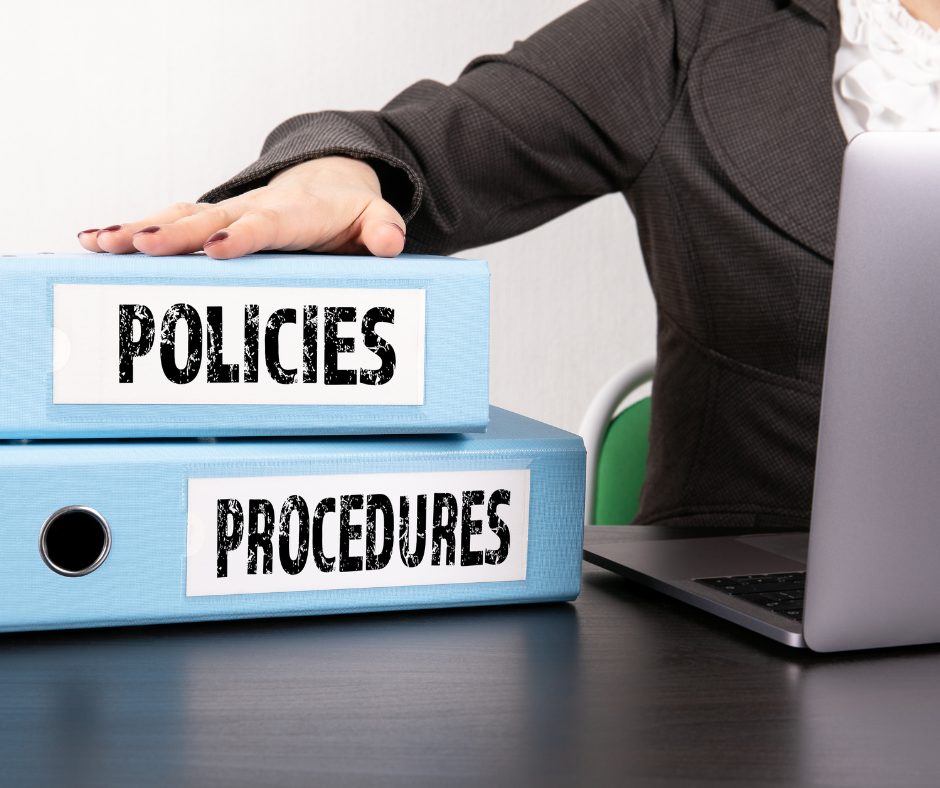
Imagine a workplace where employees are constantly unsure about how to perform their tasks, leading to confusion, inefficiencies, and a lack of productivity. Sounds chaotic, doesn’t it? This is precisely what an effective office procedure manual can prevent. In today’s fast-paced business environment, having a well-developed office procedure manual is not just a luxury; it has become a necessity. This essential document can guide your employees through their daily tasks, streamline processes, and ensure compliance with legal requirements. But what exactly goes into creating and maintaining an effective office procedure manual? In this blog post, we’ll explore the ins and outs of office procedure manuals and provide you with a step-by-step guide to creating your own.
Key Takeaways
- Understanding office procedure manuals and their importance in the workplace
- Essential elements of an effective manual, such as organizational structure & job roles, policies & procedures that comply with laws and regulations
- Step by step guide to creating a customized office procedure manual for your organization including gathering information, writing instructions and implementing/training employees
Understanding Office Procedure Manuals
An office procedure manual serves as the backbone of an organization’s day-to-day business operations. It provides a blueprint for the company’s processes, policies, and expectations, ensuring consistency and efficiency in the workplace. Think of it as a roadmap that guides employees through their responsibilities and helps them navigate potential pitfalls.
Having a well-developed manual in place can improve the communication process, reduce errors, and even save time and resources.

What is an Office Procedure Manual?
An Office Procedures Manual, also known as a procedure manual, is an all-encompassing document that outlines the standard operating procedures, policies, and expectations for employees within an organization. It serves as a reminder for employees to carry out their responsibilities diligently and efficiently.
From dress codes and hiring procedures to payroll policies and employment eligibility policies, a well-constructed manual covers a wide range of topics to ensure that every aspect of the organization runs smoothly.
Importance of Office Procedure Manuals
Maintaining a well-functioning workplace is easier with a comprehensive office procedure manual. It ensures consistency, as all employees are expected to follow the same guidelines and protocols. Additionally, a well-developed manual can streamline processes, making it easier for employees to complete their tasks efficiently and effectively.
By serving as an authoritative resource that establishes guidelines and provides answers to common employee questions, the manual can also assist in speeding up the decision-making process and increasing productivity on daily tasks. In short, the importance of an office procedure manual cannot be overstated.
Business Manual: A Comprehensive Guide to Organizational Operations
A business manual, often referred to as an operations manual or corporate handbook, serves as a fundamental guide detailing the standard procedures, policies, and practices essential for efficient organizational functioning. This meticulously crafted document encompasses critical aspects of the business, including operational protocols, employee guidelines, administrative procedures, and strategic objectives. Within the realms of a business manual, companies outline their unique methodologies, outlining workflows and delineating responsibilities to ensure streamlined operations. It acts as a compass, providing a reference point for employees to navigate the complexities of their roles, fostering consistency, compliance, and ultimately enhancing productivity. A well-structured business manual not only facilitates onboarding and training but also serves as a tool for continuous improvement, adaptation to market changes, and alignment with the overarching vision of the organization.
Essential Elements of an Office Procedure Manual

Creating an effective procedure manual that guides your employees requires careful consideration of several key elements. These essential components will ensure that the manual is comprehensive, user-friendly, and tailored to your organization’s unique needs.
Each of these significant elements will be elaborated further in the subsequent sections.
Organizational Structure and Job Roles
A well-structured office procedure manual should clearly outline the organizational structure and job roles within the company, as well as the organization’s basic business operations, including well established procedures. This includes detailing the responsibilities, reporting lines, and expectations for each position.
Fostering a sense of accountability and ownership over work is possible when employees have a clear understanding of their roles and their fit within the organization. This clarity also reduces the likelihood of confusion or misunderstandings, leading to a more harmonious and productive workplace.
Policies and Procedures
Policies and procedures form the core of any policy and procedure manual. These guidelines provide the rules, expectations, and step-by-step instructions for various tasks and processes within the organization. A comprehensive manual should cover everything from employee conduct and safety protocols to customer service standards. This ensures that employees are well-equipped to perform their duties in accordance with the organization’s values and expectations.
Errors and risks can be minimized while maintaining compliance with relevant laws and regulations through clear documentation of these policies and procedures.
Compliance with Laws and Regulations
An effective office procedure manual must also take into account the various federal or state laws and regulations that govern your organization’s operations. These can include labor laws, health and safety regulations, and data protection laws, to name a few.
Ensuring that your manual complies with these legal requirements not only helps to protect your organization from potential legal issues, but also demonstrates a commitment to ethical and responsible business practices. Furthermore, staying abreast of changes in laws and regulations and updating your manual accordingly will ensure that your organization remains compliant and prepared for any future changes.
Step-by-Step Guide to Creating an Office Procedure Manual

Now that we’ve discussed the essential elements of an office procedure manual, it’s time to dive into the process of actually creating one. While this may seem like a daunting task, breaking it down into manageable steps can make the process much more approachable.
This section provides a step-by-step guide on creating an office procedure manual, which includes gathering information and writing clear, concise instructions.
Gathering Information
The first step in creating your office procedure manual is to gather the necessary information. This involves consulting with employees, reviewing existing documentation, and researching industry best practices.
Involving employees in the information-gathering process can offer valuable insights into your organization’s most important business processes and the challenges employees face daily. Additionally, reviewing existing documentation and researching industry best practices can help to ensure that your manual is comprehensive, up-to-date, and in line with current standards and expectations.
Prioritizing Content

With all the relevant information in hand, the next step is to prioritize the content that will be included in your manual. This involves identifying which tasks and processes are most critical to your organization’s operations and focusing on detailing those procedures first.
Prioritizing the most important content makes the manual comprehensive and efficient, thus simplifying the process for employees to find and follow necessary guidelines for effective job performance.
Writing Clear and Concise Instructions
The final step in creating your office procedure manual is to write clear and concise instructions for each procedure. This is crucial, as employees will rely on these instructions to guide them through their tasks and ensure that they are performing them accurately and efficiently.
To achieve this, use clear and concise language, avoid jargon, and break down complex tasks into simple, easy-to-follow steps. Clear and concise instructions improve employees’ understanding and adherence to the manual’s outlined policies and procedures, thereby enhancing efficiency and productivity.
Utilizing Office Procedure Manual Templates

While creating an office procedure manual from scratch can be time-consuming and labor-intensive, utilizing office procedure manual templates can greatly simplify the process. These pre-made templates can provide a solid foundation for your manual, allowing you to focus on customizing the content to fit your organization’s unique needs and branding.
This section will cover the benefits of using office procedure manual templates and provide tips for personalizing them to your organization’s needs.
Advantages of Using Templates
One of the main advantages of using office procedure manual templates is that they can save you time and effort by providing a consistent format and structure for your manual. This ensures that your manual is easy to read and navigate, making it more user-friendly for your employees.
Additionally, templates often come with pre-written policies and procedures that can be easily adapted to fit your organization’s needs, further streamlining the creation process. Overall, using templates can help you create a more effective and professional-looking office procedure manual with less hassle and expense.
Customizing Templates to Fit Your Organization
Once you’ve selected a template for your office procedure manual, the next step is to customize it to fit your organization’s unique needs and branding. This involves tailoring the content, layout, and design of the template to match your organization’s policies, processes, and aesthetic preferences.
Customizing the manual template guarantees a comprehensive, relevant manual that mirrors your organization’s culture and identity. With a little creativity and attention to detail, you can easily transform a generic template into a valuable resource that is uniquely tailored to your organization.
Templates for Training Manuals
Templates for training manuals provide a structured framework and standardized format for creating instructional materials. These templates are meticulously designed to organize information in a clear and coherent manner, ensuring that essential training content is effectively conveyed to the audience. Utilizing templates for training manuals streamlines the creation process, allowing for consistent formatting of content, including sections for objectives, procedures, diagrams, and assessments. Moreover, these templates offer flexibility, enabling customization to suit the specific training needs and target audience. By utilizing pre-designed templates for training manuals, organizations can enhance efficiency, improve training quality, and facilitate a seamless learning experience for trainees.
Maintaining and Updating Your Office Procedure Manual

Once your office procedure manual is complete, it’s important to remember that it is not a static document. As your organization evolves and grows, your manual will need to be updated and maintained to ensure that it remains relevant and up-to-date.
This section will cover the importance of upkeep and updates for your office procedure manual, along with some best practices.
Scheduling Periodic Reviews
Scheduling periodic reviews of your office procedure manual is essential for identifying areas that need updating or improvement. This may include adding new procedures, updating existing ones, or removing outdated content.
Determining the best frequency for these reviews will depend on factors such as the size and complexity of your organization, the rate of change in your industry, and any legal or regulatory requirements that may apply. Regular reviews and updates of the manual maintain its value and relevance for your employees.
Involving Employees in the Update Process
Involving employees in the update process is crucial for ensuring that your office procedure manual remains accurate and relevant to their needs. By soliciting feedback from employees, you can gain valuable insights into the effectiveness of your procedures and identify areas for improvement. This can include conducting surveys, organizing focus groups, or simply encouraging open communication and feedback from employees.
Incorporating employees’ expertise and perspectives into the update process keeps the manual a valuable, current resource that supports productivity and success.
Implementing and Training Employees on the Office Procedure Manual

Once your office procedure manual is complete, it’s time to implement it and train your employees on its contents. This is a critical step in ensuring that your staff understand and adhere to the guidelines and protocols outlined in the document.
This section will highlight the importance of implementing the office procedure manual and training employees on it, along with some effective tips.
Introducing the Manual to Existing Staff
Introducing the office procedure manual to your existing staff requires clear communication and support. Begin by explaining the purpose of the manual, its benefits, and the expectations that come with it.
Provide training and support to help employees understand and follow the procedures outlined in the manual, and be prepared to answer any questions or concerns they may have.
Effectively introducing the manual to your existing staff equips them to perform their duties in line with the organization’s policies and procedures.
Personnel Policy Manual
The personnel policy manual serves as a comprehensive guide outlining the organization’s guidelines and expectations regarding employee conduct, rights, and responsibilities. This manual is a crucial document that provides clarity on various aspects, including recruitment processes, job performance expectations, employee benefits, and disciplinary procedures. It establishes a standard framework for managing the workforce effectively and ensuring consistency in how organizational policies are interpreted and applied. Additionally, the personnel policy manual often includes information on compliance with legal requirements, equal employment opportunities, and avenues for addressing grievances and concerns within the workplace. Regular updates to the personnel policy manual are essential to keep it current and reflective of evolving organizational needs and industry regulations.
Integrating the Manual into Onboarding and Training Processes
Incorporating the office procedure manual into your onboarding and training processes is essential for ensuring that new employees are familiar with the organization’s policies and procedures from the start. This can be achieved by providing the manual to new hires during the onboarding process and using it as a guide during hands-on training sessions.
Encourage new employees to refer to the manual as a resource for any questions or clarifications they may have regarding their job responsibilities. Integrating the office procedure manual into your onboarding and training processes sets new hires up for success from the get-go.
Summary
In conclusion, an effective office procedure manual is an invaluable resource that can streamline processes, improve communication, and ensure that employees are well-equipped to perform their duties in accordance with the organization’s policies and procedures. By understanding the essential elements of an office procedure manual, following a step-by-step guide to creating one, utilizing templates, and regularly maintaining and updating the manual, you can create a powerful tool that supports the growth and success of your organization. Remember, a well-developed office procedure manual is not just a luxury; it is a necessity in today’s fast-paced business environment.
Frequently Asked Questions
What is an office procedure manual?
A procedure manual is a document used by businesses to provide clear guidelines and protocols for employees. It establishes expectations for all major principles, actions, and decisions within the department or organization to ensure consistency. The manual should be comprehensive and easy to understand, so that employees can quickly and accurately follow the instructions. It should also be regularly updated to reflect changes in the organization’s policies
How do I create an office procedure manual?
To create an office procedure manual, start with an outline and set clear guidelines. Gather information on core responsibilities and create a list of priorities. Write the initial draft in a formal tone and be sure to include procedure details. Finally, send out for review and validate the procedures.
What should an office manual include?
An office manual should include the organizational mission and structure, administrative procedures, facility management, office policies related to clients and their records, employment and human resource issues, and workplace health and safety.
What are examples of office procedure?
Office procedures include planning, organizing, and guiding staff to fulfill the business’s needs. These activities help make sure all resources are properly defined, allowing successful project management.
What is the purpose of an office procedure manual?
The purpose of an office procedure manual is to provide a comprehensive guide on organizational policies, procedures, and expectations, ensuring workplace consistency and efficiency.